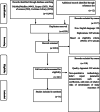Socio-demographic, clinical and service use determinants associated with HIV related stigma among people living with HIV/AIDS: a systematic review and meta-analysis
- PMID: 34551772
- PMCID: PMC8459487
- DOI: 10.1186/s12913-021-06980-6
Socio-demographic, clinical and service use determinants associated with HIV related stigma among people living with HIV/AIDS: a systematic review and meta-analysis
Abstract
Background: Defining HIV-related stigma (HRS) can be problematic due to structural inequalities, cultural differences, discrimination by health care providers and the limitations of tools measuring stigma for people living with HIV (PLWH). This meta-analysis aimed to determine self-reported HRS and its association with socio-demographic and clinical determinants.
Methods: PubMed, Scopus, Web of Science, PsycInfo, SciELO and Cochrane electronic databases were searched and after reviewing for study duplicates, the full-text of selected articles were assessed for eligibility using Population, Intervention, Comparator, Outcomes criteria. We used fixed and random-effects meta-analysis models to estimate the pooled prevalence, pooled odds ratio (OR) and 95% confidence intervals.
Results: Thirty-one studies containing 10,475 participants met the eligibility criteria. Among the potential risk factors: age > 30 years (OR = 0.93, 95%CI = 0.86, 1), living with a spouse (OR = 0.07, 95%CI = 0.02, 0.17), CD4 count < 200 (OR = 0.5, 95% CI = 0.31, 0.68), medication adherence (OR = 0.96, 95%CI = 0.94, 0.99), poor access to care (OR = 0.79, 95%CI = 0.65, 0.93), time since diagnosis, and accessibility to care (OR = 0.37, 95%CI = 0.11, 0.86) were all significantly associated with self-reported HIV stigma among PWLH.
Conclusion: Stigma is correlated with numerous negative consequences in marginalised populations including PLWH. Considering the negative association that stigma has on HIV prevention and treatment targeted evidence-based stigma reduction interventions are recommended. Interventions that are focused on a particular group, such as healthcare professionals are warranted. Rigorously designed studies with specific and validated outcome measures associated with targeted interventions may help to improve the reduction of HRS for PLWH.
Keywords: CD4 count; HIV-related stigma; Medication adherence; Time since diagnosis.
© 2021. The Author(s).
Conflict of interest statement
The corresponding author BA is an Editorial Board Member for BMC Health Services Research. The authors declare that they have no competing interests.
Figures











References
-
- Campbell C, Deacon H. Unravelling the contexts of stigma: from internalisation to resistance to change. J Community Appl Soc Psychol. 2006;16(6):411–417. doi: 10.1002/casp.901. - DOI
Publication types
MeSH terms
LinkOut - more resources
Full Text Sources
Medical
Research Materials
Miscellaneous

